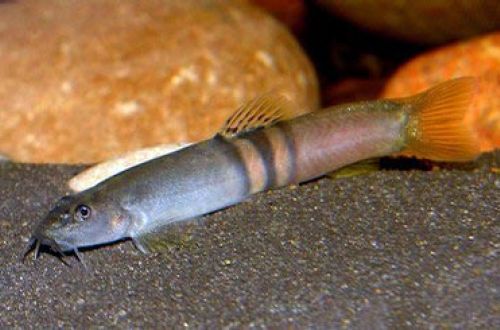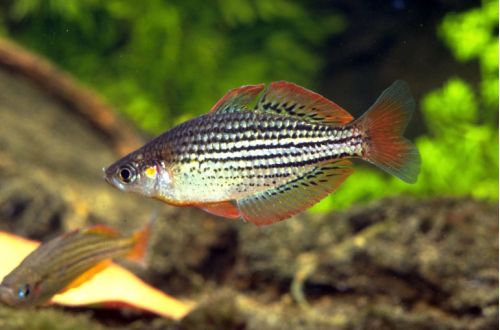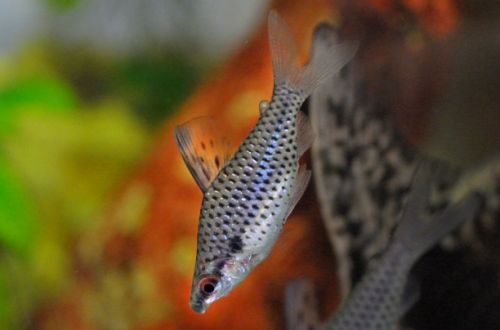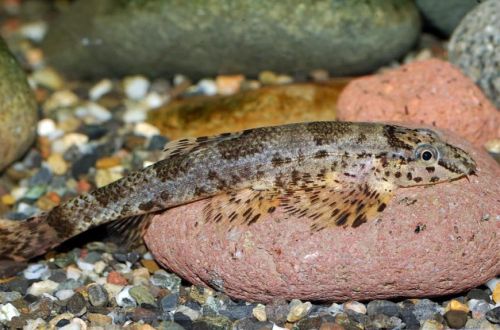
Schistura Balteata
Schistura Balteata, scientific name Schistura balteata, belongs to the Nemacheilidae family. Relatively easy to keep fish, able to get along with many other popular aquarium species. Prefers moderate water flow, which limits the number of compatible species and potentially causes some maintenance difficulties for beginner aquarists.

Contents
Habitat
It comes from Southeast Asia from the territory of southern Myanmar, Taninthai province. Inhabits the Tenasserim river basin, which also includes the border states of western Thailand, Ratchaburi and Kanchanaburi. It occurs in the upper reaches of rivers originating in the mountains. A typical biotope is a riverbed with a fast current, numerous rapids, and cascades. Dense clumps of plants, mosses and ferns grow along the coastline. The water is clean and rich in oxygen. The substrates are stony. As a rule, rivers and streams flow through the dense rainforest, where dense interlocking crowns of trees do not let the sun’s rays reach the surface of the water.
Brief information:
- The volume of the aquarium – from 80 liters.
- Temperature – 22-26°C
- Value pH — 6.0–7.5
- Water hardness – soft (2-12 dGH)
- Substrate type — stony
- Lighting – subdued
- Brackish water – no
- Water movement – moderate or strong
- The size of the fish is 7–8 cm.
- Food – any sinking food
- Temperament – peaceful
- Content in a group of at least 5–6 individuals
Description
Adults reach a length of 7–8 cm. The fish has an elongated thin body. The head is relatively small, the eyes are set high. Near the mouth are several antennae-antennae that help in the search for food. Fins translucent short. A characteristic feature of the species is the presence of two black girdle stripes running along the middle of the body. There are 3-5 dark specks on the base of the dorsal fin. The back (and sometimes the whole body) and the gap between the black stripes may turn pink or yellow.
Another related species, very similar to Schistura Balteata, is often found commercially, known as Schistura cf. Balteata. The prefix “cf.” means that biologists have yet to make a scientific description. Both fish are often confused, but since they have similar requirements for their content, confusion will not be a problem for the aquarist.
Food
Omnivorous species. In nature, it feeds on small invertebrates and partially plant material. In a home aquarium, you can serve sinking dry food in the form of flakes, granules, rich in protein. It is recommended to serve live or frozen foods such as bloodworms, brine shrimp, large daphnia, etc. on a regular basis.
Maintenance and care, arrangement of the aquarium
The optimal size of the aquarium for a small group of fish starts from 80 liters. The design should resemble the bottom of a mountain river: rocky ground with several large boulders with the addition of snags. With the help of decorative elements, shelters are created according to the number of fish. Shistura Balteata usually occupy such shelters and subsequently protect their “home” from relatives.
It is important to provide a moderate or strong internal current, simulating the rapid flow of water in the natural habitats of this species. The lighting is subdued. Live aquatic plants are usually not used due to specific conditions (substrate, flow, low light). However, there are unpretentious species that can attach to the surface of snags and other decor.
Being native to flowing waters, the fish are sensitive to the accumulation of organic waste polluting the water and low oxygen concentrations. The uninterrupted operation of the filtration and aeration system is of great importance for long-term maintenance. A good choice would be internal filters, which, in addition to their main function (water purification), will also become a source of the necessary internal flow. In addition to equipment, regular maintenance procedures contribute to maintaining biological balance: weekly replacement of part of the water (30–50% of the volume) with fresh and timely removal of organic waste (feed residues, excrement).
Behavior and Compatibility
Unlike most Golts, Shistura Balteata is quite peaceful. Of course, he is jealous of his site at the bottom of the aquarium, but he will not enter into skirmishes with relatives. However, other bottom species should be avoided. Compatible with fish capable of living in turbulent conditions, such as zebrafish, barbs and other cyprinids. Accordingly, species living in calm waters should not be chosen as neighbors.
Breeding / breeding
At the time of writing this article, there are no successful cases of breeding this species in the artificial environment of home aquaria.
Fish diseases
Health problems arise only in case of injuries or when kept in unsuitable conditions, which depresses the immune system and, as a result, provokes the occurrence of any disease. In the event of the appearance of the first symptoms, first of all, it is necessary to check the water for the excess of certain indicators or the presence of dangerous concentrations of toxic substances (nitrites, nitrates, ammonium, etc.). If deviations are found, bring all values back to normal and only then proceed with treatment. Read more about symptoms and treatments in the Aquarium Fish Diseases section.





